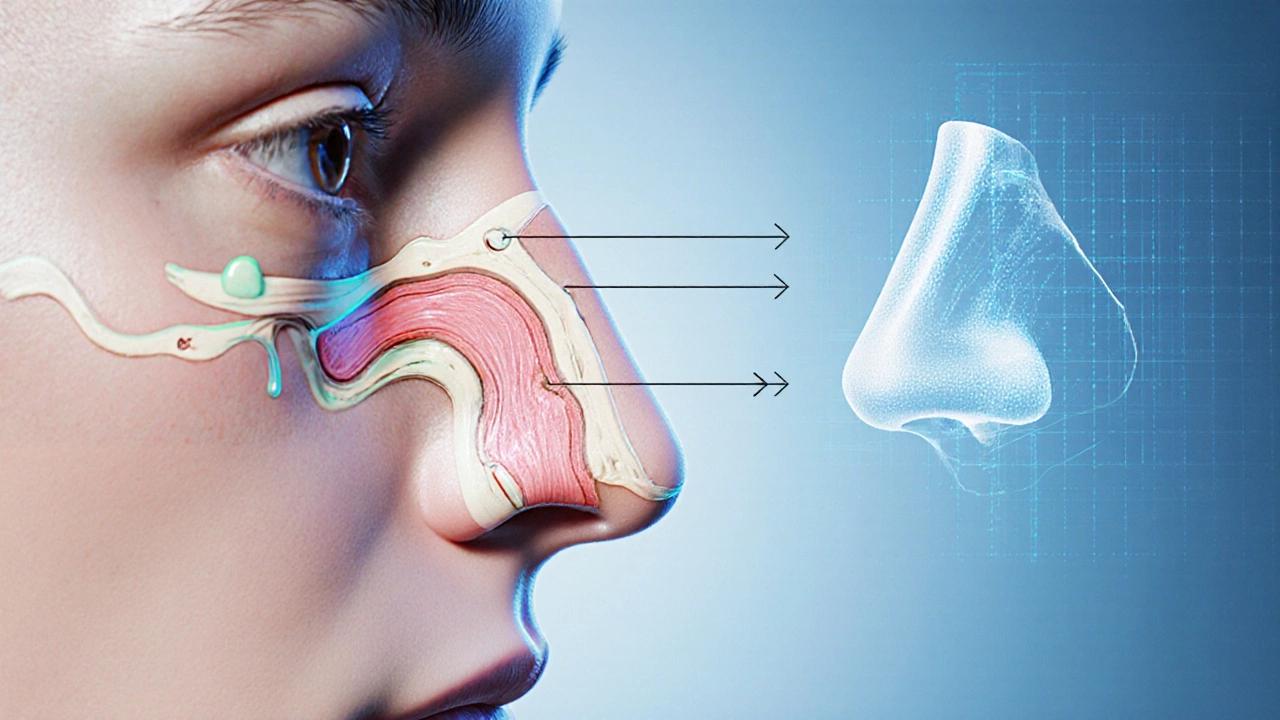Rhinoplasty Revision Risk Calculator
Assess Your Personal Risk
Based on UK data showing 15-20% average revision rate for rhinoplasty
Your Personal Revision Risk
Based on UK clinical data and your inputs
When a patient walks into a clinic promising a flawless look, the last thing on their mind is a botched result. Yet data from the UK’s Care Quality Commission (CQC) and independent audit reports show that some procedures simply carry a higher risk of revision than others. Understanding which operation tops the list of failures helps anyone considering aesthetic work to ask the right questions and choose a surgeon who can truly deliver.
What counts as a "failed" cosmetic surgery?
In the world of aesthetic medicine, "failure" isn’t just a complication that needs a quick fix. It covers three main outcomes:
- Clinical complications that require emergency treatment - for example, infection, severe bleeding, or nerve damage.
- Unsatisfactory aesthetic results that lead the patient to seek a corrective or revision procedure.
- Long‑term functional issues, such as breathing problems after a nose job or chronic pain after breast augmentation.
Risk‑adjusted failure rates are usually expressed as the percentage of patients who need a revision within two years of the original surgery. That timeframe captures most early‑stage issues while still allowing for realistic healing.
Top five cosmetic procedures with the highest revision rates in the UK
| Procedure | Average Revision Rate | Typical Complications | Key Risk Factors |
|---|---|---|---|
| Rhinoplasty - a nose reshaping surgery. | 15‑20% | Breathing obstruction, asymmetry, cartilage warping | Thin nasal skin, surgeon inexperience, unrealistic expectations |
| Breast augmentation | 10‑12% | Capsular contracture, implant rupture, ptosis | Implant type, placement plane, smoking status |
| Liposuction | 8‑10% | Contour irregularities, seroma, fat embolism | Large volume removal, aggressive suction, poor post‑op compression |
| Abdominoplasty (tummy tuck) | 7‑9% | Wound dehiscence, seroma, excess skin laxity | Obesity, multiple previous surgeries, inadequate drainage |
| Facelift | 5‑7% | Skin necrosis, nerve injury, unsatisfactory lift | Thin skin, heavy smoking, over‑tightening |
Why rhinoplasty tops the failure chart
Rhinoplasty consistently lands at the high end of the revision spectrum, and the reasons are both anatomical and procedural.
- Complex anatomy: The nose is a delicate blend of bone, cartilage, skin, and soft tissue. Small miscalculations can lead to noticeable asymmetry because the nose sits in the center of the face.
- Functional stakes: Unlike many purely aesthetic procedures, a nose job also impacts breathing. Surgeons who focus only on aesthetics sometimes overlook the nasal airway, creating post‑op obstruction that pushes patients back into the operating theatre.
- Thin skin factor: In the UK, a significant portion of the population has relatively thin nasal skin, which offers little cushion for underlying changes. This makes irregularities and visible sutures far more apparent.
- Patient expectations: Media portrayals of the "perfect nose" set a high bar. Even a technically successful surgery can feel like a failure if the outcome doesn’t match the idealized image a patient imagined.
When you add the fact that many surgeons perform only a handful of rhinoplasties each year, the odds of a less‑experienced hand taking on a high‑risk case increase dramatically.

Key factors that drive failure across cosmetic surgeries
While rhinoplasty is the leader, the underlying drivers of failure are shared among most aesthetic procedures.
- Surgeon accreditation: The UK’s General Medical Council (GMC) requires surgeons to hold a Certificate of Completion of Training (CCT) in plastic surgery, but not all providers disclose their exact volume of specific procedures.
- Patient selection: Smoking, uncontrolled diabetes, and unrealistic body‑image expectations are red flags. Studies from the Royal College of Surgeons show that smokers have a 2‑3× higher risk of wound complications.
- Implant and device quality: For breast augmentation and facial fillers, the source of the implant or filler matters. FDA‑approved silicone implants and UK‑registered hyaluronic acid gels have a better safety profile than off‑label products.
- After‑care compliance: Skipping compression garments after liposuction or neglecting prescribed antibiotics after a facelift can turn a smooth recovery into a costly revision.
How to minimise the risk of a failed outcome
Below is a practical checklist you can run through before signing any consent form.
- Verify the surgeon’s credentials on the GMC and check their BAPRAS (British Association of Plastic, Reconstructive and Aesthetic Surgeons) membership.
- Ask for the surgeon’s specific procedure volume. A reputable surgeon should comfortably quote a minimum of 50 - 100 cases per year for a single procedure.
- Request before‑and‑after photos of real patients with similar facial structures or body types.
- Discuss your health habits openly. If you smoke, commit to a 4‑week cessation program before surgery.
- Review the clinic’s infection control policies and post‑op follow‑up schedule. A good practice will schedule at least three post‑op visits in the first six weeks.
- Understand the revision policy. Some clinics offer a complimentary touch‑up within 12 months; others charge extra.
Following this roadmap dramatically reduces the chance of walking out of the operating theatre with a regretful result.

When a revision becomes necessary - what to expect
If a complication does arise, the path forward usually involves three stages:
- Assessment: Imaging (CT or MRI) to map the problem area, often done by a specialist in a tertiary centre.
- Planning: A multi‑disciplinary meeting (surgeon, anesthetist, radiologist) to decide whether a minor tweak or a full‑scale reconstruction is needed.
- Execution: The revision surgery itself, which typically takes longer than the primary operation because scar tissue must be carefully dissected.
Costs rise considerably - NHS‑funded revisions are rare for purely aesthetic issues, meaning patients usually pay out‑of‑pocket. Knowing this in advance can prevent financial shock.
Quick reference: Most failed cosmetic surgery in the UK
- Procedure: Rhinoplasty
- Average revision rate: 15‑20 %
- Primary reasons for failure: functional breathing issues, cartilage warping, patient expectation mismatch
- How to lower risk: Choose a surgeon with ≥100 rhinoplasties/year, undergo pre‑op nasal airway assessment, quit smoking, set realistic goals with a 3‑D simulation.
Bottom line
While every cosmetic operation carries inherent risk, data from the UK clearly points to rhinoplasty as the most failed cosmetic surgery in terms of revision need. That doesn’t mean you should avoid it entirely - it simply means you need to do extra homework, pick a high‑volume surgeon, and align your expectations with what anatomy can realistically achieve.
What is the typical revision rate for rhinoplasty in the UK?
National audit data from 2024 shows a 15‑20 % revision rate, meaning roughly one in five patients will need a secondary procedure to address either functional or aesthetic issues.
How can I verify a surgeon’s experience with nose jobs?
Ask for the exact number of rhinoplasties performed in the past 12 months. Reputable surgeons often publish this figure during consultations and can provide anonymised outcome data.
Are there non‑surgical alternatives to improve the nose’s appearance?
Injectable fillers can temporarily smooth minor dorsal humps or improve symmetry. Results last 12‑18 months and carry far fewer risks than surgery, but they cannot address structural breathing problems.
What post‑operative care reduces infection risk after a facelift?
Strict adherence to the surgeon’s antibiotic regimen, keeping the incision clean, avoiding heavy lifting for two weeks, and using prescribed compression garments all help limit infection and promote healthy scar formation.
Does the NHS cover revision surgery for cosmetic complications?
Only if the revision is deemed medically necessary (e.g., severe breathing obstruction). Purely aesthetic revisions remain the patient’s financial responsibility.
